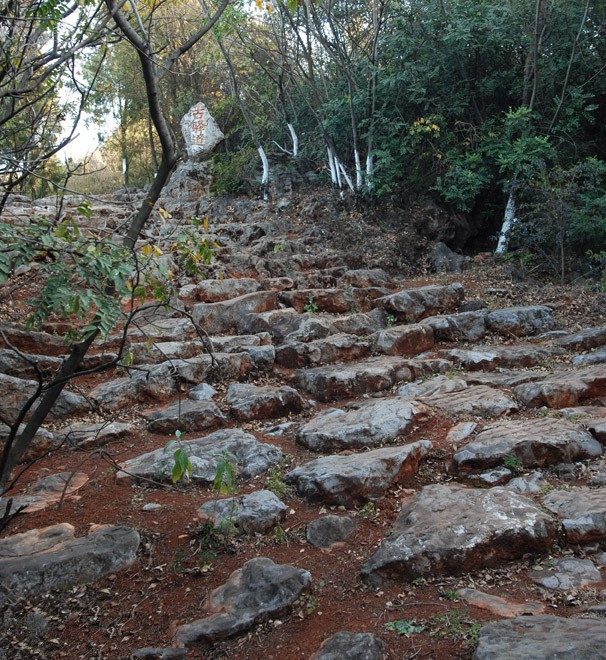Fumin Ancient Road in Kunming
Overview
The Fumin Ancient Road (富民古驿道) originates from the historical records in the “Fumin County Chronicle” (《富民县志》). It served as a courier route from Kunming (昆明, then known as Zhongqing Road) during the Yuan Dynasty to the Yuan Dynasty’s capital (present-day Beijing). The road ran through Fumin, Wuding, Huili, and Dechang before reaching Chengdu and then continuing to the capital.
Historical Background
In the 15th year of the Hongwu Era (公元1382年) of the Ming Dynasty, Fumin established a post station named Lilang Station (利浪驿), connecting three main routes to Kunming: Sancun Road (三村道), Shanxin Road (山心道), and Qingshuiguan Road (清水关道). These routes were critical passageways from Yuanmou, Wuding, and Fumin to Kunming.
To combat banditry and facilitate transportation for the public, during the Guangxu period of the Qing Dynasty (approximately 120 years ago), a new stone arch bridge was built at the exit of Wanjia Village (完家村) on Sancun Road, and a stone path was carved along the river, leading directly to Sancun Xiaocaiyuan (三村小菜园). After enduring hundreds of seasons, the ancient road has preserved deep hoofprints from mule caravans, marking its historical significance.
The ancient road in Xiyuan (熙苑) in Fumin is a remnant of the old courier route. Established during the Yuan Dynasty, it was located between Wanjia Village and Sancun and was the main passageway from ancient Yunnan to the Yuan capital (Beijing) and from Fumin to Kunming. Today, only 1.5 kilometers of the road remain. In 1954, the Shanghai Film Studio shot scenes for the movie “The Bell Rings in the Mountains” (山间铃响马帮来) along this stretch of the ancient road. Nearby attractions include Lovers Valley (情人谷) and Gem Cave (宝石洞), characterized by winding paths and lush bamboo groves.
Exploration of the Ancient Road
On January 26, following the route recorded by Xu Xiake (徐霞客) in his “Diary of Travels in Yunnan” (《滇游日记四》) from the 11th year of the Chongzhen Era (1638), a group of four of us trekked this ancient road. Throughout the thousands of years of Chinese civilization, numerous ancient paths once existed, nestled among the rugged mountains and rivers, filled with unknown dangers and poetry. These roads carried not only goods on horseback but also the civilizations at both ends.
According to the “Fumin County Chronicle,” the courier road from Kunming (昆明, then Zhongqing Road) to the Yuan capital (Beijing) during the Yuan Dynasty extended through Fumin, Wuding, Huili, and Dechang before reaching Chengdu, and then continued to the capital. Walking along the Chuan-Dian Courier Road (川滇驿道), the shade of the surrounding trees provides relief from the sun, and large rocks serve as the road surface, bearing various hoofprints created by horses. The mottled sunlight filtering through the tree shadows illuminates the stones, which, after enduring the passage of horses and people, shine brightly. This ancient road unfolds like a long scroll of history, only the wind and sand browse its pages, and the gentle rain seems to read it. Our purpose may be to follow the long string of hoofprints left by the mule caravans, to listen to the crisp ringing of the horse bells!
After walking the ancient road, we descended several steep slopes along the mountain path, heading straight to Juehai Temple (觉海寺) in Fumin. According to the county records, this temple was established during the Yuan Dynasty and was destroyed by fire in the third year of the Tongzhi Era (1862) in the Qing Dynasty, later rebuilt in the 13th year of the Guangxu Era (1887). It was officially designated as a cultural relic protection unit in 1985.
Temple Features
The temple features buildings on either side, with a long rectangular pool in the middle, spanned by a double-arch stone bridge. The elegant silhouette of the stone bridge reflects beautifully in the water; when a breeze passes, it gently sways, creating a breathtaking view. A clear pool of water and a double-arch stone bridge serve as the heart and soul of the temple. Behind the temple lies the vast and majestic Tianma Mountain (天马山), while opposite it is the distant Laoqing Mountain (老青山). These layered mountains, shrouded in mist, appear ethereal and beautiful.
In front of the temple stands a 250-year-old plum tree (梅花) that, when in bloom, fills the air with its fragrance, with blossoms floating on the surface of the water. The beauty and vitality of this plum tree evoke a captivating spirit. Even in spring, when the plum blossoms are past their peak, this ancient tree still leaves a stunning impression.
Key Attractions
- Fumin Ancient Road (富民古驿道)
- Lilang Station (利浪驿)
- Wanjia Village (完家村)
- Sancun Road (三村道)
- Sancun Xiaocaiyuan (三村小菜园)
- Xiyuan (熙苑)
- Lovers Valley (情人谷)
- Gem Cave (宝石洞)
- Juehai Temple (觉海寺)
- Tianma Mountain (天马山)
- Laoqing Mountain (老青山)
- 250-Year-Old Plum Tree (梅花)


















